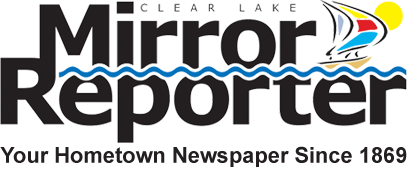EAA chapter teams with school to build an aircraft
(Above) Student Tyler Barker and EAA memebr John Baker at work on the fuselage of the ultra light under construction at Clear Lake High School.
-Submitted photo.
by Marianne Gasaway
Ken Asbe, a retired Clear Lake police officer who has loved airplanes since he was a young boy, is sharing his passion for flying with high school students in an unusual way. Asbe has spearheaded a partnership between the Clear Lake High School Industrial Arts class and Experimental Aircraft Association to build an aircraft.
The project, which is in its sixth year, was a true learning experience at its start, but the Legal Eagle XL Ultra Light is beginning to look launch-ready.
In its early days the project was slowed by glue bonding problems, as well as finding the most efficient way to get jobs done. In recent years, especially the just-completed school year, the project has really taken shape. And although he is hesitant to estimate a finish date for the project, Asbe sees the potential for it to be completed next school year.
“All the main parts are coming together and are nearly done. We still need to mount the engine and get the controls put in,” he said.
Every student may not have an interest in flight, but the planning and process involved in building an aircraft spans many subjects.
“The project appears to inspire some of the students to go into engineering, or aircraft repair,” said Asbe, adding others have shown interest in other aspects of the project, including design aesthetics. “We try to inspire students to reach their full potential, whatever that may be.”
Asbe first flew the idea of having students build an aircraft with Industrial Arts teacher Mike Lester. Lester stopped at the police station to be fingerprinted as part of the hiring process for Clear Lake Schools and Asbe seized the opportunity.
“I knew nothing about building an aircraft, but I learn along with the kids,” said Lester. “The project definitely requires students to use problem-solving skills.”
Once he had the go-ahead for the partnership with the school, Asbe set out to raise funds for the project. He raised $10,000 and secured donations which have helped to facilitate the work. Wood
[wlm_nonmember]To read more of this article, please login or sign up for our E-Edition[/wlm_nonmember][wlm_ismember]
ford Lumber and Home, in Clear Lake, got things started by donating the lumber so students could build tables to work upon.
A welded fuselage, tail surfaces and wings have been built by students. The wings and tail surfaces are fabric covered, rib stitched and then painted in Clear Lake school colors.
Asbe explained that practice wing ribs were built first, assembled on steel rib jigs, laser cut and donated by Metal Fabricators, of Clear Lake. Ribs are built from spruce and have 42 parts per rib. There are 13 ribs per wing, all individually cut by hand by students. The fuselage is chrome moly steel, the same tubing used on NASCAR rollover frames, and was built on a flat table. Tail surfaces are aluminum tube and formed aluminum parts. The 45 horsepower engine is from Hummel Engines.
Asbe said he remembers being inspired to learn more about flight after he discovered a story about the Oshkosh Air Show on the cover of National Geographic while visiting his grandparents’ home. He read the article and knew that he and his wife, Julie, had to go. They attended in 1980 and have been going ever since. The trip to the convention at Oshkosh started him thinking about what his perfect airplane would be.
In 2006 the Federal Aviation Administration granted its approval for Asbe’s RV-6 and since that time he has logged over 550 hours in his aircraft.
The ultra light under construction is actually owned by the Experimental Aircraft Association, Chapter 94, and Asbe volunteers his time to oversee the work. Other Chapter members have also shared their expertise, as well. Typically, Asbe said he has spent about two hours per school day working with industrial arts students on various aspects of the ultra light.
“In the beginning, we probably had too many kids trying to work on it. Ten or 12 at one time was too many, but we had a lot of things going on,” explained Asbe. “Over the years we have found that two to four students at a time works really well. We switch the students every few weeks. I think working on things like the trusses really gives a demonstration about how engineering works. That has helped to feed an interest in engineering that some students have had.”
The juniors and seniors involved participate through an independent study program.
“With the experience of building my own aircraft I was able to inspire students and make them understand that the only obstacle to doing anything in your life is you,” Asbe told Sport Aviation, a publication circulated among Experimental Aircraft Association members.
[/wlm_ismember]
Clear Lake Mirror Reporter
12 N. 4th St.
Clear Lake, IA 50428
Telephone: +1 (641) 357-2131
Submissions
Mid-America Publishing
This newspaper is part of the Mid-America Publishing Family. Please visit www.midampublishing.com for more information.
